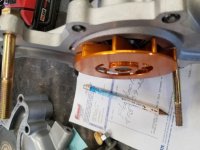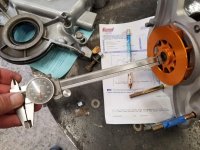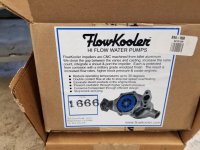I may have missed something, but are you saying it rubs metal to metal just sitting there? Or is it rubbing the feeler gauge when you stick it in the space?
If it's not rubbing when sitting there but is with the gauge, I would remove the feeler, torque it to spec then check by spinning it again.
Sounds like maybe that's your concern? That when it's fully assembled there will be interference?
I'm guessing part of the efficiency achieved is through close tolerances. But whether fifteen-thou is too tight or not, I do not know.
But if it torques down tight and does not rub anything, I personally would not be worried about it.
Of course you might be on to something if you can determine that the gasket compresses very close to that distance, perhaps .014" to leave you with theoretically only .001" remaining. I would suppose that there can be minor flexing going on, but I would bet too, that it's not very much.
There may not be many members here that can confirm your findings though. Most of us will assemble it first, then check-spin it to make sure it's not rubbing. Only if it's binding or making noise would someone pull it apart to check.
They used to have semi-engineering drawings on their website. Have you checked to see if they have that info, or if there are any good photo images of it to see if the impeller is sitting flush on the shaft?
Looks like there is about the same clearance at the vane-to-casting side as there is at the shaft-to-impeller face. Did you measure that gap too, to see how much farther up the shaft it could go before interfering?
Paul













